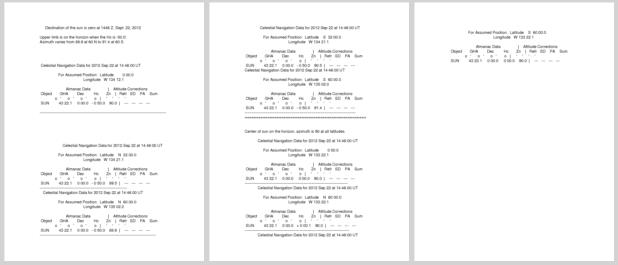
NavList:
A Community Devoted to the Preservation and Practice of Celestial Navigation and Other Methods of Traditional Wayfinding
Re: stange results from AM and PM sun shots
From: Gary LaPook
Date: 2012 Sep 28, 00:19 -0700
From: Gary LaPook
Date: 2012 Sep 28, 00:19 -0700
| It depends on how persnickety you want to be. As for your point that we call "sunrise" when the upper limb is on the
visible horizon and the center of the sun is 50 minutes below the
celestial horizon then the azimuth to the center of the upper limb will
vary slightly from straight east and west but anywhere between 32° north
and south the azimuth, rounded to a whole degree, will still be 090 and
270. Even at 60° north and south the azimuth will only be 1.4 degrees
away from east and west, see attached. With the Hc of zero the center of the sun is on the celestial horizon and you can use the amplitude table, table 27 in Bowditch, to determine the azimuth. This table gives the azimuth as 090° for all latitudes when the declination is zero. The sun's center is on the celestial horizon when the lower limb appears about 1/2 sun diameter above the visible horizon. When the sun's declination is zero, 1446 Z on September 22nd this year, it is setting at some longitude and rising at a different longitude and the amplitudes will be 270 and 90 at all latitudes on those longitudes. Due to refraction and the semidiameter of the sun, the day is always twelve hours and seven minutes long at the equator but the length of the day varies greatly at other latitudes so there is no flat "eight day" rule for determining the length of the day at all latitudes. gl --- On Thu, 9/27/12, bill <billyrem42@earthlink.net> wrote:
|







